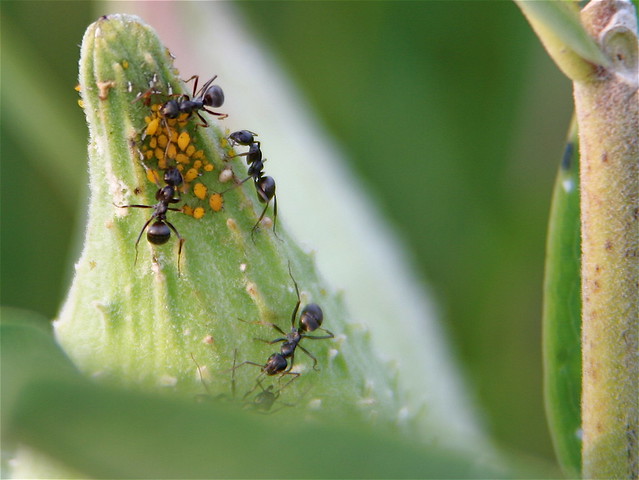Sunday, August 20, 2006
Of Ants and Aphids
Whenever I stroll through the prairie I have a special interest in checking out the milkweed population. Originally this was due to my ongoing fascination with the monarch butterfly, but over time, my fascination with milkweeds has taken on a life of its own. They typically host a very interesting assortment of colorful characters -- insects of various types sporting bright colors to advertise their toxicity after feeding on milkweed. However, there are also milkweed plants devoid of most of the more usual creatures found on the plant and instead evidencing an active patrol of black ants. Invariably upon closer inspection of these plants, one will find a colony of bright yellow oleander aphids somewhere near the top (more tender) part of the plant, attended by one or more ant guards. It is possible to find colonies of these aphids without the ants, but with a resident ant patrol, their quality of living is greatly enhanced. The aphids have many mortal enemies-- lacewing larvae, ladybug nymphs and adults, and aphid wasps to name a few, and the aphids themselves are defenseless apart from their toxicity from feeding on milkweed which deters some predators, but not, for example, the ones mentioned above. So when they're tended by ants, life is good. The ants post a guard around the aphids and then patrol the plant for invaders, killing them or driving them off. In addition, at least one research study has found that ants will remove diseased aphids from the closely packed "herd" in order to prevent the spread of disease. In return for all this care, the ants enjoy the sweet "honeydew" which the aphids secrete as they process the sap they suck from the plants.
I find such mutually beneficial relationships, of which there are seemingly countless examples to be found in creation, fascinating. Although both the ants and the aphids can and do exist independently of each other as well, there are many cases where its difficult or impossible to imagine the one species surviving without the other (the yucca plant and yucca moth are a classic example). While I know there are explanations put forth for such symbiotic relationships in evolutionary texts, I see such harmonies as yet another testament to the creative and intricate design of a world created by an infinite and all-wise creator.
Subscribe to:
Comments (Atom)

